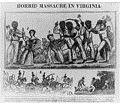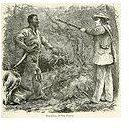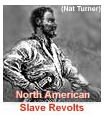Brief Study Guide on "The Confessions of Nat Turner"
Historical Background
Before moving into a literary examination, here is a brief overview of the historical events surrounding the book. Nat
Turner was a black minister who started a rebellion among the slaves in Southampton County, Virginia, on August 21, 1831. Over the next two days, Turner joined with a group of free blacks and slaves to kill 55 white people – women and children among them.
The response was swift and fierce. Hundreds of white men from Virginia and North Carolina quashed the rebellion, and then went on to kill many innocent black people as well. Most of the blacks who had participated in the rebellion were captured, but Turner went on the run, avoiding arrest for two months. He was later captured and was put to death on November 11, 1831.
Composing the “Confessions”

How did the confessions reach the reading public? Lawyer Thomas R. Gray went to talk to Turner while he was in prison, before his trial. After Turner’s execution, Gray published a pamphlet containing Turner’s first-person description of the events leading up to and after the rebellion. There are no other surviving records of Turner’s own perspective of the slave rebellion.
For a first-person narrative, though, the “Confessions” take on an unusual form. Instead of focusing on the events around the rebellion, the story begins in Turner’s childhood – and the events are not about discrimination or abuse, but about events that made Turner believe he was a prophet, that he had unusually high levels of intelligence, and that he was a natural-born planner. Such a planner, in fact, that his friends expected him to plan their mischief for them.
Elements of the story like this bring Gray’s motives into question. Having these events in the beginning, and describing his own frightened reaction to Turner’s person, makes Turner seem more like a freak than a slave who had simply had enough.
Historical Ramifications
There is a connection between the rebellion itself and the abolitionist

movement. William Lloyd Garrison had just started publishing The Liberator (an abolitionist publication) a few months before Turner’s uprising. In 1829, David Walker had written Appeai, a pamphlet advocating violent overthrow of slave owners. Turner became a hero to many abolitionists and other slaves on the run.
Questions to Consider
- There are many problems that arise when considering the reliability of Thomas Gray as a narrator. As a white slaveowner, how do you think his perception of Turner was different than a Northern abolitionist would have seen him? Or as a criminal court judge?
- Was Turner’s desire to overthrow slavery a worthy enough cause to justify the murder of white women and children? Consider the living conditions that slaves had to endure as part of your answer.
- Would Nat Turner have been able to hide out for several days after an offense like this in our own time? Why or why not?
References
- Images courtesy of Wikimedia Commons
- http://www.encyclopediavirginia.org/_Confessions_of_Nat_Turner_The_1831
- http://docsouth.unc.edu/neh/turner/turner.html
- http://www.novelguide.com/a/discover/ahlt_0001_0001_0/ahlt_0001_0001_0_00061.html
